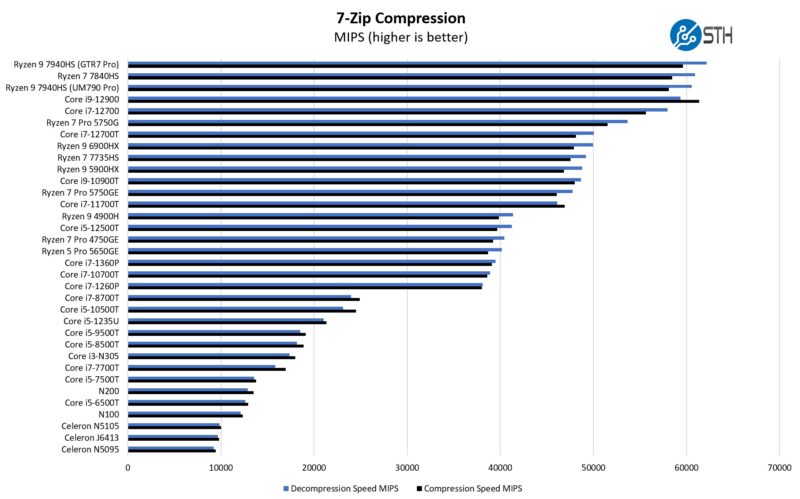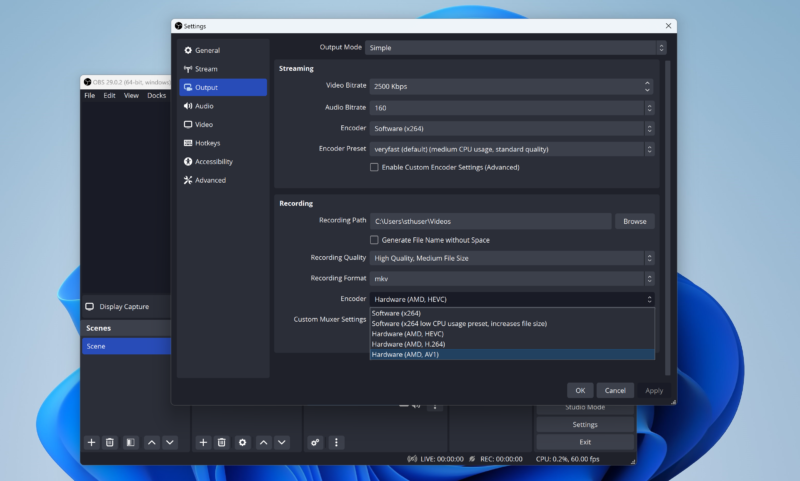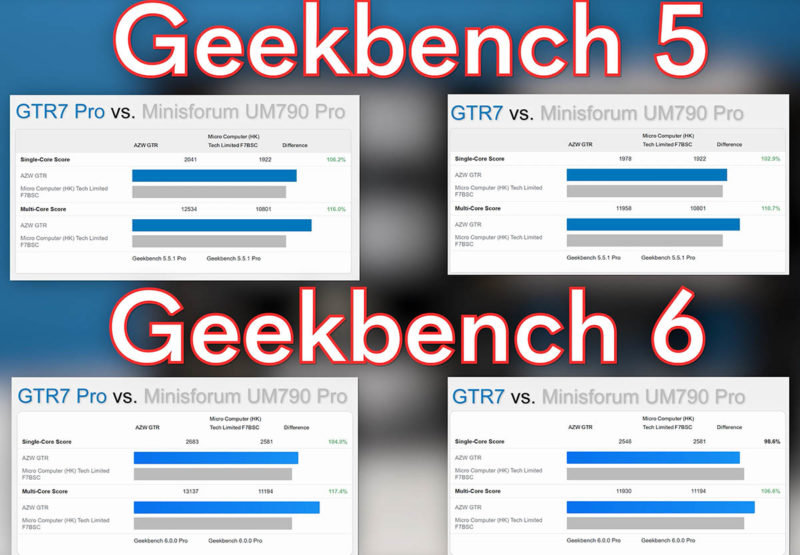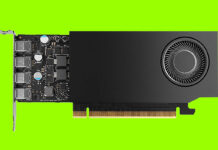Minisforum UM790 Pro Performance
Instead of going through the entire Linux-Bench test suite, we are going to show a few performance and power numbers here to give a general sense of performance. This also gives us the opportunity to test with Linux/ Ubuntu instead of just Windows.

Something that we were surprised about was that the system will let the Zen 4 cores run at 5.2GHz at times.
Python Linux 4.4.2 Kernel Compile Benchmark
This is one of the most requested benchmarks for STH over the past few years. The task was simple, we have a standard configuration file, the Linux 4.4.2 kernel from kernel.org, and make the standard auto-generated configuration utilizing every thread in the system. We are expressing results in terms of compiles per hour to make the results easier to read:

Normally systems with the same CPU are very close in performance. This is a system where that was not the case. We added both the Beelink GTR7 AMD Ryzen 7 7840HS and Beelink GTR7 Pro AMD Ryzen 9 7490HS results to the chart. Our test system was much closer to the GTR7 than the GTR7 Pro.
7-zip Compression Performance
7-zip is a widely used compression/ decompression program that works cross-platform. We started using the program during our early days with Windows testing. It is now part of Linux-Bench.

In reality, the Minisforum UM790 Pro performance was much closer than we got with the Beelink GTR7 than the GTR7 Pro.
OpenSSL Performance
OpenSSL is widely used to secure communications between servers. This is an important protocol in many server stacks. We first look at our sign tests:

Here are the verify results:

On the power consumption side, the performance difference will make sense. If you guessed the reason for this gap could be closed in BIOS, that would be accurate. Minisforum’s stock configuration is not as aggressive on power as Beelink. We tried both the pre-production unit from Beelink and the production unit we purchased, and we swapped memory and SSDs between the two to validate the performance we were seeing.
Kingston PCIe Gen4 NVMe SSD Performance
We mentioned this earlier, but the SSDs these units came with were fairly low-end PCIe Gen4 units. Here is a CrystalDiskMark run with the two PCIe Gen4 256GB Kingston drives.

Here is the 1TB drive from the production unit:

Just for comparison, here is the Crucial P3 Plus 1TB SSD that Beelink uses.

Minisforum’s Kingston 1TB SSD is relatively comparable but was only ahead in its sequential write speeds and higher queue-depth 4K random writes while falling to the P3 Plus in other metrics. On the other hand, we would probably use either a larger SSD, given 2TB SSD pricing in this class just above $100, or we would get a faster 1TB NVMe SSD if configuring a barebones.
A Word on the AMD RDNA 3 GPU
By far, the biggest update to the mini PC is not the Zen 4 CPU that is still 8 cores/ 16 threads albeit a bit faster than previous generations. Instead, it is the integrated AMD Radeon 780M based on RDNA 3. This is a great example of one of the features we get with the new GPU, the ability to use not just AV1 decode, but also encode.

In the video, we show our mini PC League of Legends test that we captured using AV1 encode via OBS.
The League of Legends testing was funny. We use that because folks asked for gaming, and it is a massively popular title that also is within the realm of running on mini PCs. We saw 60-80fps in 4K gameplay at high settings and usually 120fps+ on 1080 settings. This was more than just playable.
Geekbench Performance
We have covered the previous generation AMD Ryzen 9 6900HX to this AMD Ryzen “Phoenix” generation before. Alex when making the video did something that was really interesting comparing stock UM790 Pro Geekbench 5 and Geekbench 6 results to the Beelink GTR7 and GTR7 Pro results.

The quick summary is that the Beelink GTR7 Pro was 4-6% ahead in single thread and 16-17% ahead in multi-threaded performance with the same CPU and the GTR7 was -1.4% to 2.9% single thread and 6.6% to 10.7% ahead on multi-thread performance using the AMD Ryzen 7 7840HS.
These results were a bit more extreme than what we saw on Linux, but also there is a simple explanation: the UM790 Pro by default is using less power. Again, we tested these with two sets of components on two different units so the story was consistent.
Next, let us see how this performance translates to performance and noise.




I’m normally a reader but I like the new dbcam in the video. I don’t know when you’ve added that but it’s a nice touch.
Have you tested the wifi speed? I received my Minisforum UM790 Pro yesterday and unimpressed with the wifi connection speed as it is worse than what I get on all my laptops at home – including my Surface Book 3. It seems as if a firmware update is required.
“Street pricing ranges from around $519 to $8400”
That’s one hell of a price range! What comes with the $8400 system?
These things are still quite pricey for 8 core APU SoC on a miniscupe board.
$600 is not that far off the laptop price, which has plenty of other components ( battery, display, keyboard, trackpad etc).
This thing is essentially SoC on a miniscule board with small VRM and bunch of connectors, offering mostly the I/O that SoC has.
To Sinima:
They are pricey because of qauntity.
Cheap laptops are produced in millions. All these components are very cheap. You won’t find a Ryzen 9 7940HS in a $600 laptop. Laptops with 7940HS are much expensive.
This miniPC is produced in (tens) thousands. It’s a big difference. Try to order a thousand CPUs and try to order a hundred thousand CPUs. What price will you get for one CPU?
A great little system and I find it hard not to hit the buy button, but…
You can get a Serpent Canyon NUC12 with an A770m dGPU for €700 or €150 more, which is pretty near identical in terms of CPU performance, but quite a bit above for GPU.
Yes, it’s also a lot more power hungry when you maxi it out but not that noisy and probably not that different on idle or background stuff. Intel’s box is bigger, uglier but plenty of ports, too.
I don’t like running any of these without 10Gbit NICs and they are on par with those via TB.
And to be honest, I do like my TB ports on the back, because they are more likely to be permanently used, while USB-A is mostly temporary stuff.
Now I guess I just want an MI300A in this form factor…
Hi to all!
Anyone knows how to enable virtualization in UM790 Pro BIOS?
Is there a more detailed user manual explaining how to access BIOS and boot menu during boot?
Sorry for my english, I’m italian ;-)
Double post, because for strange reasons after a while writing this page resets and erase all text…
Just bought a barebone one, installed 64GB of Crucial 5600 RAM, a 1 GB Samsung 980 PRO M.2 NVMe and a Crucial P3 Plus 4TB M.2 PCIe Gen4 NVMe.
Also bought barebone. Installed 64GB Kingston Fury 5600 RAM, 2x WD SN850X 2TB in RAID-0. This thing is fast, love it.
Thank you for the very in-depth review.
Head that it’s the wifi antenna being the main problem. Would be great to know more about it and also know of any fixes if possible
Great review. But still, the pricing range is amazing…
Can you tell me what type of fan connector that is on the motherboard.I’d like to extend the cable.
This thing is buggy as hell. Bought one for my wife’s desktop and it crashes whenever she tries to watch netflix in Chrome/Edge/Firefox.
Currently on 1.0.5 firmware, because anything newer causes massive crashes. Currently limiting the video RAM allocation to the bare minimum, because anything more causes crashes.
I’ve seen posts saying you have to set the RAM speeds to DDR5-3200 for stability as well.
Not sure what the magic incantation is that fixes this thing, but it seems a large number of customers are complaining on their forums. Not to mention they tend to pull the firmware from their website randomly.
Bought the UM790 Pro barebones, added Crucial RAM 96GB Kit (2x48GB) DDR5 5600MT/s, fanxiang S880 4TB NVMe SSD M.2 2280 for Data, and fanxiang S880 2TB NVMe SSD M.2 2280 for Windows 11 and two or three different Linux versions. also bought Maxonar USB C to DisplayPort VESA Certified, 8K 60Hz Type C to DP Cable 6.6FT/2M ($16.99 )
Everything just worked. Date of purchase Jan 13, 2024, total Amazon cost with cable was $1,201.88.
Just had my 78th birthday, so it took me a long time to go barebones, but I found that someone else used 96 GB ram and 6 TB SSD, so barebones is the only way to get that high performance. Kind of spooky, but the return policy of Amazon makes it all possible.
The unit is rock solid, and Costco just had a sale on a 4k monitor (LG 32UN500-W Monitor 32″ UltraFine (3840 x 2160) Display, AMD FreeSync, DCI-P3 90% Color Gamut, HDR10, Built-in Speakers = $250) so I bought that yesterday! Life is good.
This is a long way from programming the 6502cpu with 16k of ram and using a tape recorder for storage.
When it works, it’s great, but mine constantly reboits – 5 times a day, which sucks for work teams calls. Crucial 2x32GB DDR5 and a 2TB Micron NVMe so shouldn’t be shonky components. At least it restarts quick.
It’s not unusable, it’s just not particularly usable for long periods of time. Shipped with 1.05 BIOS, upgraded to 1.09 (via 1.07) which was worse. Can only downgrade to 1.07. Lots of online conjecture about ram speeds and single vs. dual monitors, but who really knows?
In theory it’s a great machine, and specs wise at about £900 it’s feeling like a half finished product. In retrospect I’d have gone for a more established/mainstream brand.
Pretty disappointed. Not recommended at the moment.
Mine was doing same till updated Windows 11 Pro insider edition and AMD’s drivers, chipset, etc. My screens would go dark usually when pushing Ran and video to max. Have you tried putting your bios power on performance, with 54w (58 or in 50s), with Ram setting mt/s at 5600? You need to change Auto to Manual in bios for other settings to appear. Just be conservative when messing with Thermal or have cooling option ( I use a fan next to AC , low humidity). I noticed big difference when using LM studio to run local LM. You can also add discrete eGPU using second m.2 connector (but that is different post).